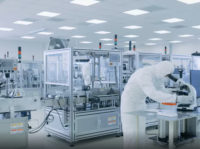Today, most industrial 3D printing is a closed shop—printers are tied to brand-specific polymers and proprietary software. That’s an obstacle to growth and antithetical to the rest of the manufacturing world, says Cosine Additive Co-founder and Chief Technology Officer Andrew McCalip.
“The basic analogy is, if you go to Home Depot and you buy a Dewalt table saw, they don’t require you to use Dewalt lumber, you just buy commodity lumber,” McCalip says. “So the way I see the 3D printing industry evolving, and for the 3D printing industry to experience exponential growth, we’re going to have to make a commodity out of the software and materials.”
The current proprietary model precludes major third-party software and polymer companies from involvement in the industry, he says, which reduces opportunities for specialization.
“So we have to fundamentally decouple software from hardware from materials,” he says. “And that way every manufacturer can concentrate on what they do best. What we do is hardware, and we feel we make exceptional, quality open-platform hardware.”
Cosine’s debut printer, the AM1, was designed with that disruptive philosophy in mind. It was unveiled at the RAPID 2015 conference.
In designing the enclosed, large-format printer, McCalip says Cosine focused on build volume and printing speed. Patent-pending technology in the AM1’s extruder heads allows it to hit rates of more than 10 pounds of material per day.
“It’s all about overall pounds, per day,” he explains. “How much can you deposit, because that ultimately means how fast you can produce a part. The philosophy is that we need useful parts quickly; it’s not useful if it takes a month.”
The machine’s open-material functionality has also allowed Cosine to partner with Techmer PM to develop new 3D printing materials like long-strand carbon fiber in a polycarbonate mixture.
“When you ask us what materials you can use on the AM1, the answer is virtually limitless,” adds John O'Connell, vice president of sales. “When I say we’re creating an open market for materials, it is to say to your R&D lab, go ahead and try new materials. Let’s get outside the box. Let’s get innovative with the materials that we’re running through the machine, and by doing so we’re going to open up a whole bunch of applications.”
Likewise, the open-platform AM1 hardware allows for customization.
“We were installing a machine at a customer’s last week, and they said ‘can we put a hole right here, can we do something special to the enclosure?’” McCalip recalls. “And the answer is ‘yes.’ We’ll go so far as to provide blueprints to our more adventurous customers who want to add in electrical or mechanical accessories. That does not void the warranty, because we learn from what they’re doing. And our customers serve as an extension of our own R&D labs. They are fantastically creative and we don’t want to hold them back.”
McCalip and O’Connell believe an open philosophy is the next step for an industry ready to move beyond its proprietary incubation.
“The technology wouldn’t have gotten here save for millions of dollars in R&D,” McCalip says. “It’s just like phones, computers or anything else. The giants developed the technology, it’s amortized over models over a period of time, and eventually an inflection point is reached and the market takes it over and runs with it.
“And we’re basically sitting right there at that inflection point. This is IBM all over again; this is the PC industry changing its trajectory. And that’s where we are with our industry. So we realize where we came from, we just want to see it keep growing.”
Ed McMenamin is the associate editor of Appliance Design. He can be reached at [email protected].













